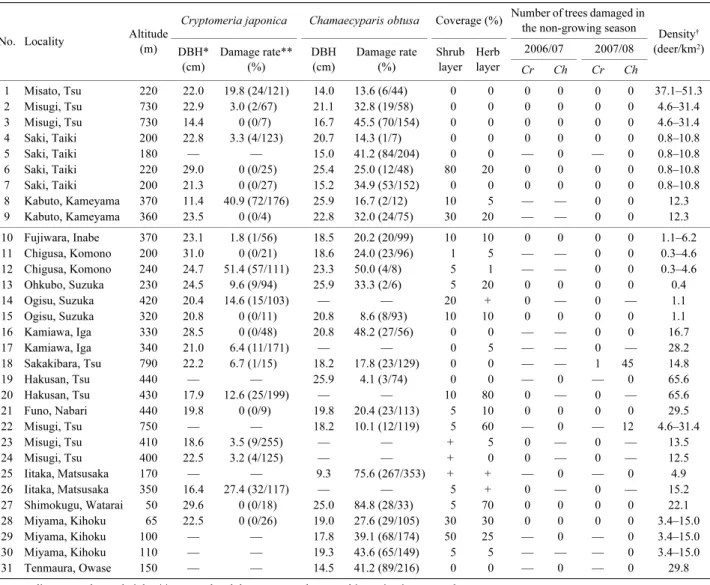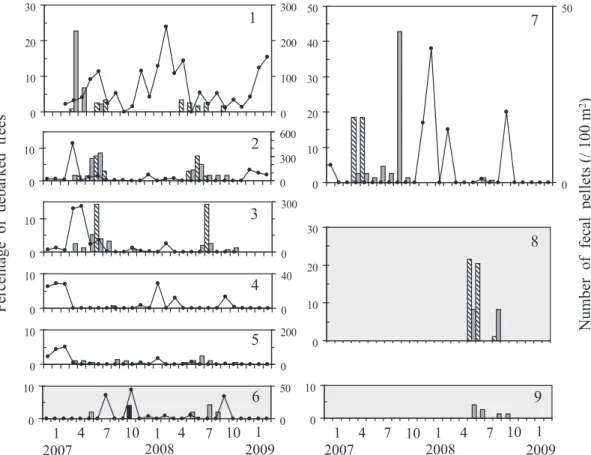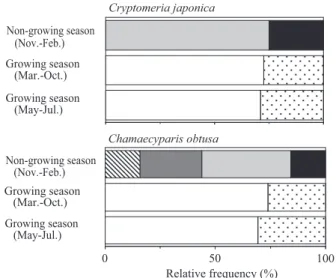原 著 論 文
日本哺乳類学会ニホンジカによるスギ,ヒノキ若・壮齢木の剥皮害の発生時期と
被害痕の特徴
佐 野 明
三重県林業研究所摘
要
三重県内 31 カ所のスギ,ヒノキ若・壮齢林において,
2006 年 11 月から 2009 年 2 月にかけて,ニホンジカによ
る剥皮害の形態別発生頻度,発生時期および被害痕の外
観的特徴の季節的変化を調べた.調査期間中に発生した
381 本の被害木のうち 99.7%は樹皮採食によるものであ
り,角こすりは 0.3%に過ぎなかった.樹皮食害のほと
んどは樹木の成長期にあたる 3 ~ 8 月に発生し,成長休
止期(11 ~ 2 月)の被害は標高 750 m 以上の 2 林分で確
認されたのみであった.成長期には内樹皮,外樹皮とも
剥ぎ取られ,内樹皮が採食されていた.露出した木部の
表面は平滑で,被害木の 73.3%では歯痕が見られなかっ
た.一方,成長休止期には内樹皮と外樹皮の間で剥離さ
れて,辺材部に張り付いた内樹皮に高密度の歯痕が残さ
れていた.樹木の成長期と成長休止期の樹皮採食痕の形
態は明瞭に区別できること,歯痕のない剥皮害を角こす
りによるものとする判断は誤りであることを指摘した.
は じ め に
ニホンジカ Cervus nippon(以下,シカ)による森林被
害が各地で激化しており,なかでもスギ Cryptomeria
japonica
とヒノキ Chamaecyparis obtusa の被害は林業経
営 上 の 深 刻 な 問 題 と な っ て い る.被 害 は 枝 葉 採 食
(browsing)と剥皮害(barking)に大別され,さらに後者
は樹皮食害(bark-feeding)と角こすり害(fraying)に分
けられる.剥皮害は幼齢木から老齢木まで広く見られ,
被害木では材内に木材腐朽菌が侵入して材質が劣化し,
幹の全周を剥がされた場合は枯死に至る重大な被害であ
る(Fig. 1;佐野 2009;佐野・金田 2009).
一方,剥皮害の形態(樹皮食害,角こすり害)別の発
生頻度と発生時期については,被害対策を検討する上で
重要な情報であるにもかかわらず,これまで調査例は少
なく,地域によっても異なることが報告されている(津
布久 1991;金森 1993;安藤・柴田 2006;Ando and Shibata
2009).
そこで,三重県内のスギ,ヒノキの若・壮齢林におけ
る剥皮害の形態別発生頻度,発生時期および被害痕の季
節的変化について明らかにしたので報告する.
調 査 地 と 方 法
調査は,三重県内のスギ 6 林分,ヒノキ 7 林分,ス
ギ・ヒノキ混交 18 林分の合計 31 林分で行われた.各調
査林分の位置を Fig. 2 に,林況を Table 1 に示す.なお,
調査木の多くは樹齢が不明であったが,胸高直径はス
ギで 6 ~ 50 cm,ヒノキで 6 ~ 54 cm であり,本論文で
はこれらを幼齢期を過ぎた若・壮齢木として扱った.三
重県ではスギ,ヒノキの剥皮害はきわめて広範囲に発
生していることから,調査区は県の北部から南部にか
けて広く設定した.すべての調査区で剥皮害を認めた
Fig. 1. Sugi (Cryptomeria japonica) debarked by sika deer (Cervus nippon). a) mass mortality of 22-year-old trees (study plot No. 8); b) sap rot by wood-decay fungi in a debarked tree (study plot No. 12).
が,累積被害本数率,標高,シカの生息密度および林
内の下層植生について,さまざまな条件の調査区が混
在するように配慮した.とくに下層植生は,調査区 No.
1 ~ 5,7,16,18,19 および 31 では全く見られず,No. 11,
12,17,23 ~ 26 および 30 ではわずかに認める程度で
あった.また,比較的多くの下層植生が見られる調査
区については,No. 6,9 および 15 ではヒサカキ Eurya
japonica
,No. 14 ではネズミモチ Ligustrum japonicum,
No.
20と22ではネザサPleioblastus chino var. viridis,No. 28
ではソヨゴ Ilex pedunculosa と,それぞれシカが好んで採
食する植物が優占していたが,No. 8,10,13,21,27 お
よび 29 ではそれぞれシキミ Illicium anisatum,シロダモ
Neolitsea sericea
,ヤマアイ Mercurialis leiocarpa,モチツ
ツジ Rhododendron macrosepalum,コシダ Dicranopteris
linearis
,イズセンリョウMaesa japonicaという不嗜好性植
物が優占していた.
いずれの調査林分においても 30 m 四方の調査区を設
定し,その中のすべての生立木について樹種,胸高直径
および剥皮害の有無,被害がある場合は被害形態を記録
した.また,低木層と草本層の植被率と優占種も記録し
た.2007 年と 2008 年,あるいはそのいずれかの年の 3 月
に,糞粒法によって各調査区周辺のシカの生息密度を推
定した.すなわち,各調査区の周辺に 50 m のラインを 10
本設け,5 m ごとに(合計 110 カ所に)1 辺 1 m の方形枠
を置いて糞粒数を数え,その値を生息密度推定プログラ
ム「FUNRYU プログラム」(岩本ほか 2000)に当てはめ
て算出した.
調査区 No. 1 ~ 7 では 2006 年 11 月から 2009 年 2 月ま
で,No. 8 と 9 では 2007 年 8 月から 2009 年 2 月まで,原
則として 1 カ月間隔で新たな剥皮害の発生の有無を記録
した.さらに No. 1 ~ 7 では調査区の四隅と中央部に 5 m
四方の小プロットを設定し,調査日毎にすべての糞粒を
回収してその数を数えた.
それ以外の調査区では,原則として 2006 年 11 月と
2007 年 2 月,2007 年 11 月と 2008 年 2 月に調査を行って,
それぞれの期間における新たな剥皮の発生の有無を調
べた.
調査期間中に発生した樹皮食害木(スギ 129 本,ヒノ
キ 251 本)については被食部位を記録するとともに,剥
皮面の任意の場所に原則として長さ 5 cm のラインを水
平方向に 2 ~ 6 本引き,それに交差する歯痕本数を数え
た.ライン 10 cm あたりの交差本数をその剥皮面の歯痕
密度とした.なお,全調査区内で樹木の成長休止期にあ
たる 11 ~ 2 月に剥皮されたスギは 1 本のみであったの
で,2009 年 1 月に調査区 No. 18 周辺で確認された 3 本に
ついても補完的に調査対象に加えた.
角こすり害と樹皮食害との区別は,角によって樹皮を
傷つけたものの,剥がれた樹皮を採食していないものを
前者とし,角を利用して剥皮したと推測される場合でも
剥離した樹皮を採食した痕跡があるものはすべて後者と
した.
結
果
1.剥皮害の発生時期
全調査区内のスギ 1,929 本,ヒノキ 2,577 本のうち,
11 ~ 2 月の成長休止期に剥皮害の発生が認められたの
は,標高 750 ~ 790 m に位置する 2 つの調査区(No. 18,
22)のスギ 1 本とヒノキ 57 本のみであり(Table 1),こ
Fig. 2. Map showing locations of sugi and hinoki cypress plantationsinvestigated in Mie Prefecture, central Japan. Gray squares indicate plantations where monthly investigations were carried out. For local-ity number, see Table 1.
れらはすべて樹皮食害であった.なお,これら 2 調査区
でも,被害は調査時に積雪を認めなかった 2006 年 11 月
から 2007 年 2 月には発生せず,平坦な林道上に 20 cm 以
上の積雪を確認した 2007 年 11 月から 2008 年 2 月に発生
した.
また,通年調査が行われた 9 つの調査区における剥皮
害の発生状況を Fig. 3 に示す.樹皮食害は,スギでは
No.
3で2007年6月と2008年7月,No. 7で2007年3~4月,
No.
8で2008年5~8月に,ヒノキではNo. 1で2007年3月,
No.
7 で 2007 年 8 月に顕著な発生のピークを認めた.全体
としてはスギ,ヒノキとも樹木の成長期にあたる 3 ~ 10 月
に発生し,なかでも 3 ~ 8 月にスギでは全被害の 98.4%,
ヒノキでは 94.3%が集中していた.
一方,角こすり害については 2007 年 10 月に調査区
No.
6 のスギ 1 本に発生したのみであった.
糞粒の消失速度は気象条件や分解者である糞虫類の生
息・活動状況によって大きく変わるため(岩本ほか 2000;
池田ほか 2002),糞粒密度によってシカによる林分利用
頻度の季節的変化を論じることはできないが,調査区
No.
1~7では11~2月の成長休止期においても糞粒を認
めて,林分の利用が確認された.No. 8,9 でも 2007 年 12
月,2008 年 1 月,12 月および 2009 年 1 月には新鮮な糞
粒が,2008 年 2 月には積雪上に多数の足跡が確認された.
すなわち,いずれの調査区も樹木の成長休止期にもシカ
が利用していたが,樹皮食害と角こすり害は発生しな
かった.
Table 1. Stand description and actual state of sika debarking damage in study forest stands
No. Locality Altitude (m)
Cryptomeria japonica Chamaecyparis obtusa Coverage (%) Number of trees damaged in
the non-growing season Density†
(deer/km2) DBH* (cm) Damage rate** (%) DBH (cm) Damage rate (%) Shrub layer Herb layer 2006/07 2007/08 Cr Ch Cr Ch 1 Misato, Tsu 220 22.0 19.8 (24/121) 14.0 13.6 (6/44) 0 0 0 0 0 0 37.1–51.3 2 Misugi, Tsu 730 22.9 3.0 (2/67) 21.1 32.8 (19/58) 0 0 0 0 0 0 4.6–31.4 3 Misugi, Tsu 730 14.4 0 (0/7) 16.7 45.5 (70/154) 0 0 0 0 0 0 4.6–31.4 4 Saki, Taiki 200 22.8 3.3 (4/123) 20.7 14.3 (1/7) 0 0 0 0 0 0 0.8–10.8 5 Saki, Taiki 180 — — 15.0 41.2 (84/204) 0 0 — 0 — 0 0.8–10.8 6 Saki, Taiki 220 29.0 0 (0/25) 25.4 25.0 (12/48) 80 20 0 0 0 0 0.8–10.8 7 Saki, Taiki 200 21.3 0 (0/27) 15.2 34.9 (53/152) 0 0 0 0 0 0 0.8–10.8 8 Kabuto, Kameyama 370 11.4 40.9 (72/176) 25.9 16.7 (2/12) 10 5 — — 0 0 12.3 9 Kabuto, Kameyama 360 23.5 0 (0/4) 22.8 32.0 (24/75) 30 20 — — 0 0 12.3 10 Fujiwara, Inabe 370 23.1 1.8 (1/56) 18.5 20.2 (20/99) 10 10 0 0 0 0 1.1–6.2 11 Chigusa, Komono 200 31.0 0 (0/21) 18.6 24.0 (23/96) 1 5 — — 0 0 0.3–4.6 12 Chigusa, Komono 240 24.7 51.4 (57/111) 23.3 50.0 (4/8) 5 1 — — 0 0 0.3–4.6 13 Ohkubo, Suzuka 230 24.5 9.6 (9/94) 25.9 33.3 (2/6) 5 20 0 0 0 0 0.4 14 Ogisu, Suzuka 420 20.4 14.6 (15/103) — — 20 + 0 — 0 — 1.1 15 Ogisu, Suzuka 320 20.8 0 (0/11) 20.8 8.6 (8/93) 10 10 0 0 0 0 1.1 16 Kamiawa, Iga 330 28.5 0 (0/48) 20.8 48.2 (27/56) 0 0 — — 0 0 16.7 17 Kamiawa, Iga 340 21.0 6.4 (11/171) — — 0 5 — — 0 — 28.2 18 Sakakibara, Tsu 790 22.2 6.7 (1/15) 18.2 17.8 (23/129) 0 0 — — 1 45 14.8 19 Hakusan, Tsu 440 — — 25.9 4.1 (3/74) 0 0 — 0 — 0 65.6 20 Hakusan, Tsu 430 17.9 12.6 (25/199) — — 10 80 0 — 0 — 65.6 21 Funo, Nabari 440 19.8 0 (0/9) 19.8 20.4 (23/113) 5 10 0 0 0 0 29.5 22 Misugi, Tsu 750 — — 18.2 10.1 (12/119) 5 60 — 0 — 12 4.6–31.4 23 Misugi, Tsu 410 18.6 3.5 (9/255) — — + 5 0 — 0 — 13.5 24 Misugi, Tsu 400 22.5 3.2 (4/125) — — + 0 0 — 0 — 12.5 25 Iitaka, Matsusaka 170 — — 9.3 75.6 (267/353) + + — 0 — 0 4.9 26 Iitaka, Matsusaka 350 16.4 27.4 (32/117) — — 5 + 0 — 0 — 15.2 27 Shimokugu, Watarai 50 29.6 0 (0/18) 25.0 84.8 (28/33) 5 70 0 0 0 0 22.1 28 Miyama, Kihoku 65 22.5 0 (0/26) 19.0 27.6 (29/105) 30 30 0 0 0 0 3.4–15.0 29 Miyama, Kihoku 100 — — 17.8 39.1 (68/174) 50 25 — 0 — 0 3.4–15.0 30 Miyama, Kihoku 110 — — 19.3 43.6 (65/149) 5 5 — — — 0 3.4–15.0 31 Tenmaura, Owase 150 — — 14.5 41.2 (89/216) 0 0 — 0 — 0 29.8
* mean diameter at breast height. ** accumulated damage rate when stand investigations started.
† deer population density estimated by the pellet count method in March of 2007 or/and 2008.
Fig. 3. Seasonal changes in the ratio of debarked trees and density of fecal pellets. Numerals in each figure indicate locality (study plot) number. Gray bar, oblique lined bar and black bar indicate bark-feeding to hinoki cypress, bark-feeding to sugi and fraying on sugi, respectively. Solid line represents density of fecal pellets. Plots with colored background (No. 6, 8 and 9) indicate plots with understory vegetation. In plots No. 8 and 9, the investigation started from August 2007, but pellets were not counted.
Fig. 4. External characters of sugi and hinoki cypress debarked for feeding by sika deer. a) a hinoki cypress debarked during the growing season (April); b) exposed surface of the xylem of a sugi debarked in June (without teeth-marks); c) a sugi debarked during the growing season (June). Outerbark (black arrow) was taken off and thick innerbark (white arrow) was eaten; d) a hinoki cypress debarked during the non-growing season (February); e) exposed surface of innerbark in a hinoki debarked in winter, there are many teeth-marks on the filmy innerbark adhering to the xylem; f) outerbark scattering around a hinoki cypress debarked during the non-growing season.
2.樹皮食害痕の特徴
樹木の成長期に樹皮食害された 128 本のスギと 194 本
のヒノキの露出した辺材部表面は概して平滑で(Fig. 4a,
b
),全く歯痕を認めないものがスギでは 74.2%,ヒノ
キでは 72.7%を占め,平均(±標準偏差)歯痕密度は
スギで 0.22±0.47 本,ヒノキで 0.17±0.32 本であった
(Fig. 5).外樹皮は被害木の周辺に落とされ,肥厚した内
樹皮が採食されているのが共通の特徴であった(Fig. 4a,
c
).とくに,角のない時期や袋角成長期にあたる 5 ~ 7 月
の被害木についても,歯痕のないものがスギ,ヒノキで
それぞれ 71.0%と 69.2%を占め(Fig. 5),歯痕のないも
のを角こすりによる,あるいは樹皮食害には歯痕を伴う
ものとする判断(樋口・豊島 1987;関 1991;金森ほか
1993;桑畑 1996)は誤りであることがわかった.
一方,成長休止期に調査区とその周辺で樹皮食害され
た 4 本のスギと 57 本のヒノキは,いずれも外樹皮と内樹
皮の間で剥離されて,根元には外樹皮が散乱していた.
この時期における内樹皮は薄い膜状で辺材部に強く接着
していたことを示す.また,内樹皮を削りとるように,
辺材部に達する多数の歯痕が見られた(Fig. 4d, e, f).
平均歯痕密度はスギでは 19.75±1.93 本,ヒノキでは
12.51±6.66 本に達し(Fig. 5),両樹種とも成長期のそ
れに比べて顕著に多かった(Welch の t 検定,両樹種とも
P
<0.001).
以上のように,樹木成長期と成長休止期に樹皮を食害
されたスギ,ヒノキの剥皮部にはそれぞれ特徴があり,
両者は明確に区別できた.
考
察
スギ,ヒノキ若・壮齢木の剥皮害の実態については,
これまで報告例が少なく,さらに地域によっても異なる
(Table 2).すなわち,剥皮害の主体は島根県(金森ほか
1993)や鹿児島県(谷口 1993)では角こすり害とされる
が,福岡県(池田・桑野 2008)では角こすり害と樹皮食
害の両方が見られ,栃木県(Ueda et al. 2002),兵庫県
(尾崎 2004)および奈良県(Ando et al. 2004)では三重県
と同様に樹皮食害を主体とする被害が報告されている.
発生時期についても,角こすり害は主として秋季であ
るのに対して,樹皮食害では地域差が大きい.すなわち,
栃木県の標高 640 ~ 890 m にあるヒノキ林では冬季に集
中していたが(Ueda et al. 2002),兵庫県のスギ林(尾崎
2004)と福岡県のヒノキ林(池田・桑野 2008)では主と
して夏季に発生していた.また,奈良県大台ケ原ではヒ
ノキの樹皮食害は通年見られ,剥皮面積に季節による有
意差はなかったと報告されている(Ando et al. 2004).こ
れらの地域に比べて,三重県では春季も含めた樹木の成
長期に集中的に発生しており,それは被害の程度,下層
Fig. 5. Comparison of density of deer teeth-marks on exposed sur-face of debarked trees. Density is represented by the number of teeth-marks crossing over a horizontal line (/10 cm) randomly drawn on exposed stem surfaces: , 0; , <2; , 2–5; , 5–10; , 10–20; , >20. In May to July, males have no antlers or growing velvet antlers, and cannot cause fraying damages.Table 2. Summary of deer barking damage to young and middle-aged sugi and hinoki cypress in Japan
Damage pattern Species Locality Forest age Damage Season References
bark-feeding
Cryptomeria japonica Hyogo 43 Jun–Aug (Jul–Aug) Ozaki 2004
Chamaecyparis obtusa Tochigi 39–44 Jan–Feb Ueda et al. 2002
Chamaecyparis obtusa Nara * the whole year Ando et al. 2004
Chamaecyparis obtusa Fukuoka 24 May–Dec (May–Jul) Ikeda and Kuwano 2008 fraying
Cryptomeria japonica Shimane 18–25 Aug–Mar (Sep–Nov) Kanamori et al. 1993 Chamaecyparis obtusa Fukuoka 24, 37 Sep–Jan (Sep–Oct) Ikeda and Kuwano 2008 Chamaecyparis obtusa Kagoshima 13 Sep–Mar (Oct–Nov) Taniguchi 1993 Damage season: Peak season is given in parentheses.
植生,あるいはシカの生息密度に関わりない特徴であっ
た.ただし,二つの調査区(No. 18, 22)で積雪が冬季の
樹皮食害を招く可能性が示唆され,間接的要因としての
標高の影響については今後の検討を要す.
樹皮食害の誘因として,冬季に発生する被害について
は餌不足が挙げられているが(飯村 1980,1984;関 1983;
Ueda et al.
2002),春~夏季の被害については明らかでな
い.スギ,ヒノキ以外の針葉樹については奈良県大台ケ
原のトウヒ Picea jezoensis var. hondoensis とウラジロモミ
Abies homolepis
では餌条件の良い夏季に最も激しい樹皮
食害が発生し,その原因として,林内の下層を占めるミ
ヤコザサ Sasa nipponica を夏季に食べるとルーメン胃内
の異常発酵がおこり,これを抑えるために消化しにくい
樹皮を食べるという仮説が提示されている(Ando et al.
2004).また,Jiang et al.(2005)は山梨県富士山北麓にお
いてシラビソ Abies veitchii の樹皮食害が 3 ~ 4 月をピーク
として発生し,これは樹皮の栄養条件が最も良くなる時
期と一致するとしている.いずれも興味深い指摘である
が,スギ,ヒノキにも当てはまるかどうかは不明である.
本研究においても,スギ,ヒノキの樹皮食害の原因を
明らかにすることはできなかったが,三重県においては
冬季の被害はほとんど見られないことから,餌不足以外
の要因の存在が強く示唆された.樹皮の「剥がれ易さ」
に関しては,スギでは 1 月と 10 月に比べて 4 月と 7 月に
は樹皮の木部への接着力が低下し(Oi and Itoya 1997;大
井 1999),ヒノキでも秋季に比べて早春季と夏季には,樹
皮を剥がす際の引っ張り強度が低下することが報告され
ている(安藤 2004).また,成長休止期には内樹皮は辺
材部に固着しているが,肥大成長が盛んな時期には樹皮
は形成層の内側で剥離されるという(黒田慶子 私信).
すなわち,成長期におけるスギ,ヒノキの内樹皮は肥厚
して(Fig. 4c),糖類の通導組織を伴って容易に剥離され
る.一般に樹皮は粗繊維質が多く,質の低い食物とされ
るが(Faber 1996;Yokoyama and Shibata 1998;Ando et al.
2004),成長期のスギ,ヒノキの内樹皮は大量かつ集中的
に存在し,効率的に入手できるという利点もあり,食物
メニューの中で相対的に高く位置づけられている可能性
が高い.
現在,全国で新植造林面積が減少しており(林野庁
2008),シカによるスギ,ヒノキの成木剥皮は林業におけ
る獣害の中で最も深刻な問題といえる.その発生実態は
地域によって異なり,樹皮食害と角こすり害を正しく区
別し,その発生時期を把握することは対策を講じる上で
も重要である.本研究の結果,樹皮食害の場合は継続的
な調査をしなくても,剥皮痕跡の外観的特徴,すなわち,
歯痕密度と剥皮面における内樹皮の有無を観察すること
でおおよその発生時期を把握できることがわかった.ま
た,角こすり害と樹皮食害の区別に際しては,樹幹表面
における歯痕の有無のみを根拠とせず,根元に掻き落と
された樹皮を観察して,内樹皮の採食の有無を確認する
必要がある.
謝
辞
本研究を進めるにあたり,多くのご助言をいただいた
岐阜大学応用生物科学部の安藤正規博士,独立行政法人
森林総合研究所関西支所の黒田慶子博士,森林施業 NPO
法人森林の風の瀧口邦夫氏,現地調査にご協力くださっ
た特定非営利活動法人サルどこネット,調査をお許し下
さった森林所有者のみなさまに深く感謝する.
引 用 文 献
安藤正規.2004.ニホンジカによる樹木剥皮発生機構に関する 基礎的研究.名古屋大学大学院博士論文,138 pp. 安藤正規・柴田叡弌.2006.なぜシカは樹木を剥皮するのか? 日本森林学会誌 88: 131–136.Ando, M. and Shibata, E. 2009. Bark-stripping preference of sika deer and its seasonality on Mt. Ohdaigahara, central Japan. In (D. R. McCullough, S. Takatsuki and K. Kaji, eds.) Sika Deer Biology and Management of Native and Introduced Populations, pp.207– 216. Springer, Tokyo.
Ando, M., Yokota, H. and Shibata, E. 2004. Why do sika deer, Cervus nippon, debark trees in summer on Mt. Ohdaigahara, central Japan? Mammal Study 29: 73–83.
Faber, W. E. 1996. Bark stripping by moose on young Pinus sylvestris in South-central Sweden. Scandinavian Journal of Forest Research 11: 300–306. 樋口輔三郎・豊島重造.1987.造林地における獣害とその対策. 財団法人林業科学振興所,東京,125 pp. 飯村 武.1980.シカの生態とその管理.社団法人大日本山林 会,東京,154 pp. 飯村 武.1984.シカによる森林被害とその防除(III)被害は どのようにして起こるか.森林防疫 33: 195–197. 池田浩一・桑野泰光.2008.福岡県古処山地におけるシカによ る造林木剥皮害の発生時期.九州森林研究 61: 101–104. 池田浩一・野田 亮・大長光 純.2002.シカ糞の消失と糞の 分解消失に及ぼす糞虫の影響.日本林学会誌 84: 255–261. 岩本俊孝・坂田拓司・中園敏之・歌岡宏信・池田浩一・西下勇 樹・常田邦彦・土肥昭夫.2000.糞粒法によるシカ密度推 定式の改良.哺乳類科学 40: 1–17.
Jiang, Z., Ueda, H. and Kitahara, M. 2005. Bark stripping by sika deer on veitch fir related to stand age, bark nutrition, and season in northern Mount Fuji district, central Japan. Journal of Forest Research 10: 359–365.
6–11. 金森弘樹・井ノ上二郎・周藤靖雄・原 誠・遠田 博・周藤成 次・岩佐啓次.1993.島根県弥山山地におけるニホンジカ に関する調査(III)―生息数・被害の推移と被害回避試験 ―.島根県農林水産部林政課,松江,42 pp. 桑畑 勤.1996.動物の林業被害ハンドブック(獣類編).全国 森林病虫獣害防除協会,東京,13 pp. 大井 徹.1999.ニホンジカによる林業被害防除のための生態 学的研究.東北森林科学会誌 4(2): 25–28.
Oi, T. and Itoya, Y. 1997. Nutritional evaluation of Cryptomeria japonica damaged by sika deer (Cervus nippon). In (B-Y. Lee, S-G. Lee, and B-H. Yoo, eds.) Forest Protection in Northeast Asia, pp. 284–291. Forestry Research Institute, Seoul.
尾崎真也.2004.兵庫県におけるニホンジカによるスギ壮齢林 の樹皮摂食害の実態.森林応用研究 13: 69–73. 林野庁.2008.平成20年度版森林・林業白書.社団法人日本林 業協会,東京,172+31+41 pp. 佐野 明.2009.三重県亀山市で発生したシカの剥皮によるス ギ若齢木の集団枯損.森林防疫 58: 9–10. 佐野 明・金田英明.2009.ニホンジカによるスギ剥皮害に対 するテープ巻きの防除効果.森林防疫 58: 11–13. 関 勝.1983.シカとその林木被害について.森林防疫 32: 40–43. 関 勝.1991.森林に加害する獣類とその被害防除(7)―獣 種の判別―.山林 1289: 40–47. 谷口 明.1993.シカによる造林木の被害防除に関する研究 (III)―スギ・ヒノキ造林木の剥皮被害―.日本林学会九州 支部研究論文集 46: 155–156. 津布久 隆.1991.シカ・カモシカによる造林木被害の形態. 森林野生動物研究会誌 18: 37–41.
Ueda, H., Takatsuki, S. and Takahashi, Y. 2002. Bark stripping of hinoki cypress by sika deer in relation to snow cover and food availability on Mt Takahara, central Japan. Ecological Research 17: 545–551.
Yokoyama, S. and Shibata, E. 1998. The characteristics of Sasa nipponica grassland as a summer forage resource for sika deer on Mt. Ohdaigahara, central Japan. Ecological Research 13: 193– 198.
ABSTRACT
Occurrence of deer barking damage to young and middle-aged sugi and hinoki cypress,
and characteristics of feeding scars
Akira Sano
Mie Prefecture Forestry Research Institute, Nihogi 3769-1, Hakusan, Tsu, Mie 515-2602, Japan
E-mail: sanoa00@pref.mie.jp



